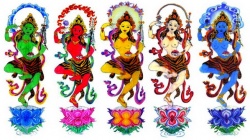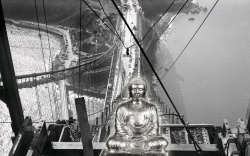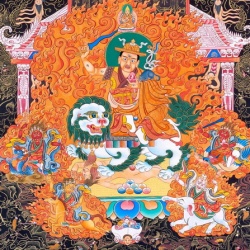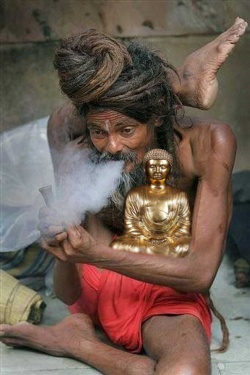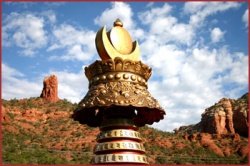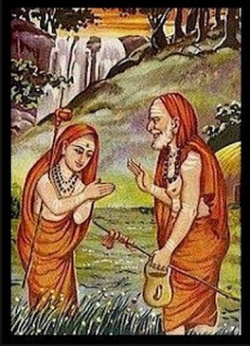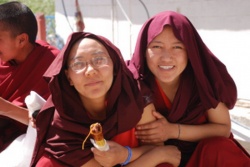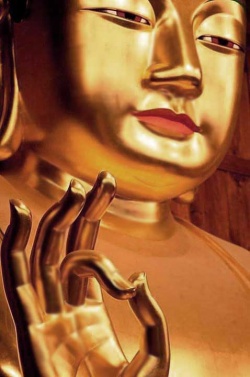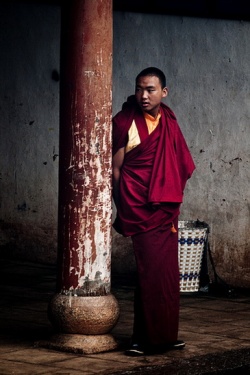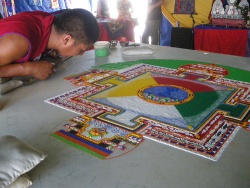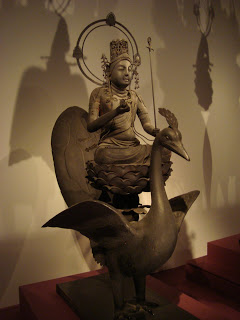Buddhist Sorcery and Astrology in East Asia
Buddhist Sorcery and Astrology in East Asia
By Indrajala (Jeffrey Kotyk)
As we discussed earlier, it was after the fifth century that the Mahāyāna slowly emerged from the fringes to become a much more mainstream and perhaps sought after component of Buddhism in India. The Mahāyāna had license to employ expedient means for both mundane and spiritual matters alike. The capacity for engaging in mundane affairs no doubt contributed to the forward development the Mahāyāna enjoyed come the feudal period in India that accompanied the demise of the Gupta empire (c.550).
However, China displayed a special appreciation for Mahāyāna scriptures and practices early on. By the fifth century many scriptures had been translated and the teachings consolidated when Kumārajīva (344-413) arrived and translated a number of texts while also clarifying questions. It seems likely that early on many Mahāyāna proponents fled India or Central Asia to settle in a more favorable culture. Some of the early Mahāyāna monks in China might have effectively been refugees.
Here I want to take a basic look at Buddhist sorcery in the Sinosphere (i.e., East Asia). We should understand sorcery here as a means by which one achieves mundane aims via the summoning and direction of non-corporeal beings and/or setting patterns in motion at a primarily mental level. In relation to this we should also consider other more occult practices like astrology.
As to the origins of Buddhist sorcery, we can actually see very early on in the Pāli canon mention of non-corporeal beings offering protection to the Buddha (I hesitate to say “supernatural beings” because that implies they are outside causality, whereas these beings are subject to causality, though people do not normally perceive them). One example of this is the Atanatiya Sutta where the four Mahārāja (Dhṛtarāṣṭra, Virūḍhaka, Virūpākṣa and Vaiśravaṇa, who attend to guarding the four cardinal directions) pay homage to the Buddha and offer protection whenever needed to him and his followers:
- "Surely bhante, there are disciples of the Blessed One. They frequent the remote recesses of forest and woodland wilderness where there is no sound, no tumult, where breezes are void of human contact, and suitable for man's seclusion and quiet contemplation. There are eminent Yakkhas who haunt these forests, who have no faith in the word of the Blessed One.
- "Bhante, may the Blessed One learn the Atanata protection so that the displeased Yakkhas may be pleased, so that the monks and nuns, laymen and laywomen, may be at ease, guarded, protected and unharmed."
This protection is made available to practitioners. It is effectively the summoning of friendly non-corporeal beings to protect oneself. This idea could be extended to other uses. For instance, instead of warding off hostile nāgas, one might see to directing them towards bringing rain during a drought. This is indeed what we later see.
In an earlier post Buddhism is Pagan we also looked at how Buddhism, both the Mahāyāna and Śrāvakayāna varieties, is basically polytheist with a deep concern, even anxiety, about deities and their activities. The contemporary idea that gods are irrelevant to Buddhist practice ignores both the early canon (such as the Atanatiya Sutta above) and later commentary literature which expresses concerns about all manner of celestial beings. Buddhist cultures have generally throughout history found it expedient to employ Dharma guardians, whose images were not just for decoration.
When it comes to summoning nāgas, devas and other such non-manifest beings for the purposes of directing them to some mundane aim, historically it has generally always been that practitioners saw these as actual beings in their own right with subjective experiences of their own, and not a reflection of elements in one's own psyche. Both eastern and western magic alike employ the summoning of immaterial beings. In the Buddhist context, if one is summoning nāgas to bring rain, it is assumed that these are in fact real beings, albeit not normally perceived, who can influence the weather.
Now, let us consider several of the notable scriptures which form the core of Buddhist sorcery in the Sinosphere.
The Sūtra on Golden Light Brilliance 金光明經 (Skt. Suvarṇa Prabhāsōttama Sūtra). There are a few translations of this text, the earliest being done by Dharmakṣema (385-433) between 414-421. It is often seen as a scripture for state protection. The four Mahārāja are said to offer protection to the state and people by virtue of the scripture being venerated. Chapter six sees the four of them addressing the Buddha and speaking of how they will aid both king and subjects alike if the scripture is recited and its proponents respected:
- 《金光明經》卷2〈6 四天王品〉:「世尊!如諸國王所有土境,是持經者若至其國,是王應當往是人所,聽受如是微妙經典,聞已歡喜,復當護念恭敬是人。世尊!我等四王,復當勤心擁護是王及國人民,為除衰患令得安隱。」(CBETA, T16, no. 663, p. 341, a14-18)
- World Honored One! If someone should bring this sūtra to the lands possessed by a king, this king should go to this man and hear so profound a scripture as this. Having heard it there will be rejoicing. Further, he should care for and venerate this man. World Honored One! We Four Kings [[[deva]] kings) should also diligently guard this king and the peoples of his country, to prevent calamities and ensure peace.
Concern for the four Mahārāja is seen in a text translated around the same time in 427, the Four Deva Kings Sūtra (Skt. *Catur Devarāja Sūtra):
- 《四天王經》:「諸天齋日,伺人善惡,須彌山上即第二忉利天,天帝名因,福德巍巍,典主四天,四天神王,即因四鎮王也,各理一方。常以月八日遣使者下,案行天下,伺察帝王臣民、龍、鬼、蜎蜚、蚑行、蠕動之類,心念、口言、身行善惡;十四日遣太子下;十五日四王自下;二十三日使者復下;二十九日太子復下;三十日四王復自下。」
- The devas on the fasting days examine the good deeds and misdeeds of people. Atop Mount Sumeru there is the second [[[desire realm]] heaven) of Trāyastriṃśa where there is the celestial sovereign named Indra whose virtues are lofty. The chief four devas, the four deva kings, are Indra's four guardian kings, each managing one direction. On the eighth day envoys are always dispatched who descend on an inspection tour of the whole world. They investigate the sovereigns, kings, officials, citizens, nāgas, spirits, fliers, crawlers and wrigglers – the good deeds and misdeeds in the thoughts of their minds, the speech of their mouths and the actions of their bodies. On the fourteenth day he dispatches the princes who descend. On the fifteenth day the four kings themselves descend. On twenty-third day the envoys again descend. On the twenty-ninth the princes again descend. On the thirtieth day the four kings again personally descend.
This deep interest in the activities of gods was not limited to Mahāyāna literature as it is also found in Indian Śrāvakayāna texts such as the Abhidharma Mahāvibhāṣā Śāstra and Sarvāstivādanikāya Vinaya Mātṛkā (see here).
In Japan the Sūtra on Golden Light Brilliance was one of three traditional sūtras employed for protecting the state (護國三部經), the other two being the Lotus Sūtra and Benevolent King's Sūtra 仁王經. This was established as such by Saichō 最澄 (767-822) in 806. He mentions it in 818 in his “Six Articles” 六條式:
- 《天台法華宗年分學生式一首》(六條式 ): 凡止觀業者,年年毎日,長轉長講,法華,金光,仁王。守護諸大乘等護國衆經。
- Shikan activities [止觀業]: every day of every year we will constantly turn and constantly expound the Lotus Sūtra, Sūtra on Golden Light Brilliance and Benevolent King's Sūtra, the protective Mahāyāna sūtras for protecting the country.
This no doubt justified the resources and funding for such a monastic operation, which facilitated further opportunities to engage in serious practice. This idea of preserving the well-being of the country via the activities of the sangha incidentally was a contributing factor in the generous state support Buddhist institutions received around East Asia in this period. The widespread belief in both malicious and benevolent deities, and the welfare of the state often relying on the latter, encouraged the elites to invest heavily in religion. A well-developed and complex religion like Buddhism with its large canon and monastic system was one such beneficiary. In the satellite tributary realms around Tang China, such Silla, Pohai and Japan, the existence of a sangha also demonstrated a capable level of state and cultural development, thus reducing the image of outer barbarians.
The Benevolent King's Sūtra, one of the three aforementioned state protecting scriptures, is unique in that it is directed at rulers. It is also considered to be an apocryphal text originating in China. There was a second version of the text done by Amoghavajra 不空 (705-774), which includes additional esoteric material on dhāraṇīs, maṇḍalas and mantras. Sixteen kings present themselves seeking to ask about the causes and conditions with which they can protect their countries. The prajñāpāramitā is credited with protecting the country:
- 《佛說仁王般若波羅蜜經》卷1〈4 二諦品〉:「大王!此經名為“仁王問般若波羅蜜經”。汝等受持般若波羅蜜經,是經復有無量功德,名為護國土功德,亦名一切國王法藥,服行無不大用。護舍宅功德,亦護一切眾生身。即此般若波羅蜜,是護國土,如城塹牆壁刀劒鉾楯,汝應受持般若波羅蜜,亦復如是。」(CBETA, T08, no. 245, p. 829, c16-21)
- Great Kings! This sūtra is called the Sūtra of the Benevolent Kings' Inquiry of the Prajñāpāramitā. You should receive and uphold this Prajñāpāramitā Sūtra. This sūtra also possesses immeasurable merit, called the merit of protecting the country, also called the Dharma medicine of all kings, which when applied is always of great use. The merit of protecting household is also protecting the bodies of all beings. Here in this prajñāpāramitā, this protection of the country is like city defenses, a wall, a blade, a spear and shield. You should also receive and uphold the prajñāpāramitā like this.
In chapter five, specifically entitled “Protecting the Country” 護國, it is said that should the country come under attack a hundred Dharma Masters should be asked to expound the prajñāpāramitā. It also states that benevolent spirits will offer their protection if said sūtra is recited twice daily:
- 《佛說仁王般若波羅蜜經》卷2〈5 護國品〉:「大王!一日二時講讀此經,汝國土中有百部鬼神,是一一部復有百部,樂聞是經,此諸鬼神護汝國土。」(CBETA, T08, no. 245, p. 830, a7-9)
- Great King! Twice a day recite this sūtra and in your country there will be a hundred divisions of spirits, each of these divisions also possessing a hundred divisions, who will delight in hearing this sūtra. These spirits will protect your country.
Such a program would of course required trained clergy who would devote themselves to such an ongoing task. They would have had to possess a degree of literacy as well as be suitably ordained. In various East Asian countries state resources were invested in such people and institutions with the expectation that all manner of calamities could be avoided by virtue of the good graces of such protective entities. This indeed helps to explain why in China, Korea and Japan so many monasteries were built and paid for by central governments. There was of course additional utility to be found in having a corp of well educated monks for various purposes. In any case, such an arrangement effectively meant the relevant monks were under state control.
Another noteworthy scripture entitled the Sūtra on Dhāraṇīs for Guarding the Realm and Ruler 守護國界主陀羅尼經. It was translated into Chinese in 790 by Prajñā and Muniśrī (these two were incidentally Kūkai's Sanskrit teachers in Chang'an). It is said it was adapted to the culture of China, though two-thirds of it does correspond to the Tibetan (see DDB).
One idea expressed in the text is that a king plays a primary role in the spiritual welfare of his people, his own spiritual strength acting as a means through which the country as a whole is pacified and free of distress, hence the buddhas are especially inclined towards protecting them.
- 《守護國界主陀羅尼經》卷9〈9 陀羅尼功德軌儀品〉:「善男子諦聽諦聽當為汝說。諸佛如來非不住於平等三昧。由平等故守護國王。善男子譬如良醫見小嬰孩。身縈疾病不勝醫藥。乃以良藥令母服之。由母服藥力及於乳。其子飲乳疾病皆除。諸佛如來亦復如是。哀愍一切守護國王。」(CBETA, T19, no. 997, p. 566, a11-17)
- Good sons, Listen well! Listen Well! I will teach you. All the buddha-tathāgatas abide in the samādhi of equality. It is due to that equality that they protect sovereigns. Good sons, it is like a good doctor seeing a small infant. Wrought with illness it cannot stand medicine, so the mother is made to take it. The power of the medicine the mother takes extends into her milk. The child drinks the milk and the illness is completely eliminated. The buddha-tathāgatas are also like this. They have sympathy for all and protect sovereigns.
It goes on to say that by virtue of protecting the ruler one protects the crown prince, who when protected enables the great ministers to likewise be protected, onward down to the common people who enjoy ease owing to their ruler's well-being. The ruler plays a key role as he is said to enable great peace and prosperity among his subjects should he practice the dhāraṇī included in the sūtra:
- 《守護國界主陀羅尼經》卷9〈9 陀羅尼功德軌儀品〉:「若諸國王受持於此陀羅尼門。能令無量無數眾生。現在安樂長守尊貴。身壞命終得生善道。是知國主善能關閉諸惡趣門。開示人天涅槃正路。故我偏說守護國王。」(CBETA, T19, no. 997, p. 566, a27-b2)
- If sovereigns receive and uphold this dhāraṇī, they can enable immeasurable and innumerable beings to be immediately at peace, constantly protected and venerated. When they die they will attain birth on a good path. Hence know that the ruler of a country can close the doorways to unfortunate destinies. They reveal the direct path to nirvāṇa for gods and men. Thus, I particularly teach on protecting sovereigns.
The appeal of such a teaching to rulers in China and elsewhere like Tibet would have been presumably great. Such a teaching not only justifies and enhances the temporal and religious powers of the ruler, but the common people are likewise encouraged to consent to the hierarchy. This indeed reflects the post-Gupta (c.550 CE onward) religious shifts towards reliance on authority and legitimization of power in a feudal society.
The practice itself is effectively benevolent magic where the ruler sets in motion patterns in the world by way of the dhāraṇī. It is accompanied by samaya precepts and consecration by an ācārya. There are other dhāraṇīs in the text which deal with stopping excessive rains or to make invading forces disperse. Naturally these magical arts would have been of interest to rulers, but the masters of such arts likewise would have held special status and treated appropriately.
In respect to summoning rains, there is a specific text entitled the Mahāmegha Sūtra 大雲輪請雨經, which provides a dhāraṇī specifically for this purpose. There were four translations of the text, the earliest being in 570 by Magadha monk Jñānayaśas. The sūtra commences with the Buddha at the palace of the nāga king Upananda (one of the eight nāga kings) along with his bodhisattva and bhikṣu company as well as numerous other nāga kings, all of whom pay their respects with incalculable precious substances, performances and so on before walking around him clock-wise and then standing to one side. Several dhāraṇīs are taught to the nāgas, one of which is described as follows:
- 《大雲輪請雨經》卷2:「於未來世若亢旱時能令降雨。若滯雨時亦能令止。飢饉疾病亦能除滅。普告諸龍令使知聞。復令諸天歡喜踊躍。能摧諸魔安隱一切有情。」(CBETA, T19, no. 989, p. 488, c14-17)
- In future worlds should there be a time of drought it can make rain fall. If a time when bogged in rains, it can also halt it. It can also eliminate famine and disease. Announce it widely to the nāgas and have them know it. It will further make the devas leap and dance in joy. It can crush māras and set at ease all beings.
There is a famous story where Kūkai at Shinsen'en 神泉苑 in Kyōto summoned rain during a famine caused by drought. In 824 at the age of 51 he performed a rite derived from the above sūtra, requesting that the third nāga princess of the Nāga King Sāgara, she being an emanation of Cintāmaṇicakra Avalokitēśvara Bodhisattva 如意輪觀音, to come from the snowy mountains of the Himalayas. After a week she appeared and rain poured down. It is said that she took up residence at Shinsen'en and an appropriate shrine was built for her.
A rather earlier scripture dealing with mantras is the Mahāmāyūrī Vidyārājñī Sūtra 孔雀明王經, sometimes just known as the Peafowl Sūtra 孔雀經,which was first translated in the fourth century. The early translation is quite brief. The introductory passage is followed by the mantra. The introduction reads as follows.
- 《大金色孔雀王咒經》卷1:「佛告阿難。往昔於雪山王南。有一金色孔雀王。佛住其中。彼以此大孔雀王呪經。朝說自護晝則平安。暮說自護夜則安隱。」(CBETA, T19, no. 986, p. 477, c6-8)
- The Buddha said to Ānanda, “Long ago to the south of Himālaya Girirāja, there was a golden peacock king. The Buddha resided with him. It was with this incantation scripture of the great peacock king that the day would be peaceful if recited in the morning as an observance, and the night settled if recited in the evening as an observance.”
Here the Chinese describes the being as a king, not a female. Mahāmayūrī (literally “great peahen”) later is definitely feminine and one of the non-wrathful Vidyārājñī, which is in contrast to other male figures like Ācala. She is also described as a bodhisattva. The image of the peacock eating troublesome insects is analogous to removing afflictions. The ability of a peafowl to predict rain also makes the deity associated with rain summoning. She generally has four arms, but in the Garbhadhātu Maṇḍala 胎藏界曼荼羅 she is placed in the susudi section, where she has two arms while sitting atop a red lotus. Curiously in the Tibetan tradition the deity has three faces, eight arms and sits on a lotus, but does not ride a peafowl.
The matter of astrology is also of relevance to our discussion. In an earlier post Ethnicity in Tang Buddhist Art we took a look at the painting from Dunhuang "Tejaprabhā Buddha and the Five Planets". It was based on the astrological text the Brahma Horanavagraha 梵天火羅九曜, which was translated by Yijing 一行 (683-727), an esoteric monk who had studied under Śubhakarasiṃha 善無畏 and Vajrabodhi 金剛智. The text itself provides methods for making appropriate offerings to the nine luminaries as well as the accompanying mantras plus details on when things are auspicious or inauspicious.
Another astrological text is the Sūtra on Mañjuśrī Bodhisattva and the Sage's Teaching on Auspicious and Inauspicious Times, Days, Good and Evil Constellations and Luminaries 文殊師利菩薩及諸仙所說吉凶時日善惡宿曜經, translated by Amoghavajra in 759 and revised in 764 by disciple Yang Jing Feng 楊景風 under his master's guidance. It details the relationship between astronomical bodies (for instance the twenty-seven classical Indian constellations, twelve zodiacal mansions, sun, moon, planets and so on) and the fortunes and misfortunes of people, functioning as a Buddhist text on both Indian astrology and divination. The text is divided into eight chapters and includes two charts.
It provides information on astrological lore, including the genesis of the cosmos. The essences of heat and cold morphed into the sun and the moon with the five stars (the visible planets) acting as retainers. The twenty-seven constellations moved the twelve zodiacal mansions, giving rise to myriad phenomena. These twelve zodiacs houses 十二宮 are identical those found in western astrology. They are given in the following order and suitable occupations are advised for those born under the respective signs.
| Chinese |
English |
Optimal Profession |
| 師子 |
Leo |
Army |
| 女 |
Virgo |
Palace quarters |
| 秤 |
Libra |
Storehouse |
| 蝎 |
Scorpio |
Nursing |
| 弓 |
Sagittarius |
Greater Minister / Commander |
| 磨竭 |
Capricorn |
Executions |
| 瓶 |
Aquarius |
College |
| 魚 |
Pisces |
Government official |
| 羊 |
Aries |
Kitchen |
| 牛 |
Taurus |
Stablemaster |
| 夫妻 |
Gemini |
Gatekeeper |
| 蟹 |
Cancer |
Punishment litigator |
These professions are all key occupations in a palace, and not ordinary professions.
It is generally held that at some point Greek astrology was absorbed into India, perhaps after Alexander the Great (356-323 BCE) with the Indo-Greek kingdom. Hellenic influences even influenced language as in the ancient northwest Indian language of Gāndhārī for instance there is the word stratego. Eventually Buddhists came to adopt Indian astronomy and this was transmitted to China where the zodiacs were translated. The traditional Chinese zodiac remained dominant, but nevertheless Buddhists had a zodiac component in their astrology that was originally Greek.
Sorcery and astrology played important roles in Buddhism across East Asia for most of its history. Arguably in some cases these were the primary practices that many educated Buddhist clergy engaged in rather than meditation and other transmundane aims, though the texts frequently speak of benefiting beings through such activities. Many eminent figures in East Asian Buddhist history actually secured their special privileges, particularly funding for monastic complexes and other projects, by demonstrating knowledge and skill in the occult arts of Buddhism. In the modern day there are still some who study such subjects, though I would think such individuals are relatively scarce. I have heard that rain summoning rites are still done in Japan. Nevertheless, I believe contemporary Tibetan lamas have a better preserved understanding of occult arts plus active traditions which engage in them.

